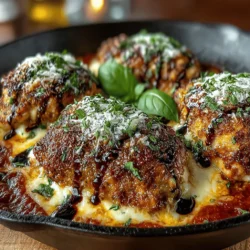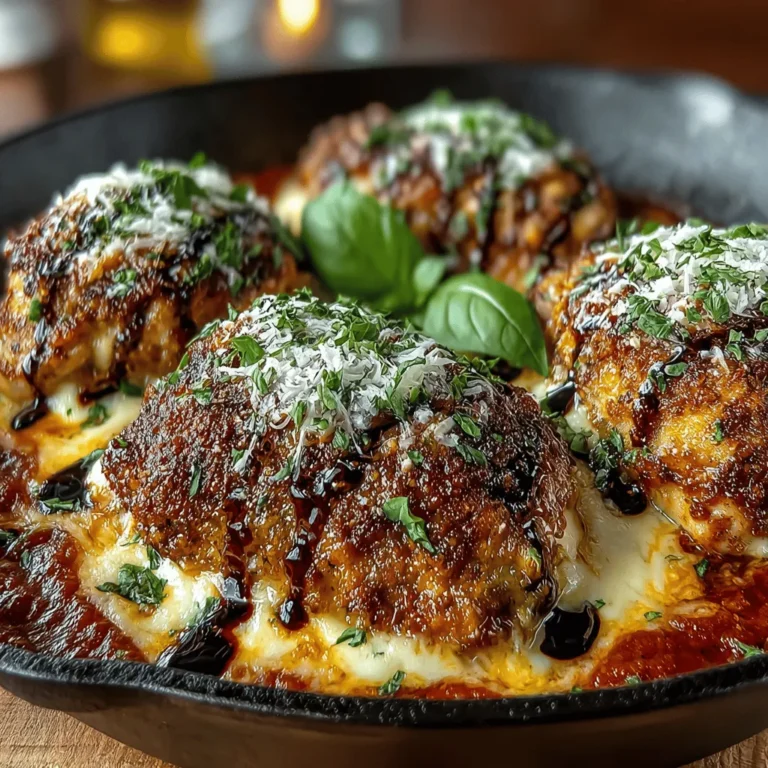Neapolitan Chicken Skillet Delight: A Flavorful Journey to Italy
If you’re searching for a delicious, wholesome meal that captures the essence of Italian cuisine, look no further than Neapolitan Chicken Skillet Delight. This dish combines succulent chicken thighs with a medley of Italian-inspired ingredients, resulting in a comforting and satisfying meal that is sure to please the entire family. Not only does this recipe boast rich flavors, but it also offers the convenience of quick preparation and minimal cleanup—perfect for busy weeknights when time is of the essence.
The appeal of Neapolitan Chicken Skillet Delight lies in its ability to bring the heart of Italy into your kitchen without demanding hours of your time. The combination of tender chicken, vibrant marinara sauce, and cheesy goodness makes this dish a favorite among both seasoned home cooks and Italian food enthusiasts. Whether you’re looking to impress guests or simply whip up a hearty dinner for your family, this recipe provides the perfect solution.
The Inspiration Behind Neapolitan Chicken Skillet Delight
The origins of Neapolitan cuisine are rooted in the coastal city of Naples, Italy, where fresh ingredients and bold flavors reign supreme. This region is famed for its pizzas, pasta, and an abundance of vegetable dishes, all showcasing the high quality of local produce and seafood. Neapolitan cuisine emphasizes simplicity and freshness, transforming everyday ingredients into extraordinary meals that evoke the warmth of Italian hospitality.
Traditional Italian chicken dishes often feature marinated or roasted chicken, enriched with herbs and spices that capture the essence of the Mediterranean. The Neapolitan Chicken Skillet Delight pays homage to these classic flavors while adapting them for modern cooking convenience. By utilizing a skillet method, this recipe minimizes cooking time and allows for easy one-pan preparation—ideal for the fast-paced lifestyles of today’s home cooks.
Ingredients Breakdown
To create this delightful dish, a few key ingredients play pivotal roles in achieving the perfect balance of flavor and texture:
– Boneless, Skinless Chicken Thighs: These cuts are ideal for this recipe due to their tenderness and rich flavor. Unlike chicken breasts, thighs remain juicy even when cooked at higher temperatures, making them a reliable choice for skillet cooking.
– All-Purpose Flour: This ingredient is essential for creating a crispy coating on the chicken. It helps absorb moisture, allowing the breading to adhere better and create a deliciously crunchy exterior.
– Eggs: Acting as a binder in the breading process, eggs ensure that the breadcrumbs stick to the chicken, forming a cohesive layer of flavor.
– Italian-Seasoned Breadcrumbs: These breadcrumbs provide both texture and flavor, enhancing the overall taste of the dish. The blend of herbs and spices in the breadcrumbs complements the Italian theme beautifully.
– Marinara Sauce: Often regarded as the heart of Italian dishes, marinara sauce adds moisture and depth of flavor to the chicken. It’s a staple in many Italian recipes, and its vibrant tomato base is perfect for a comforting skillet dish.
– Mozzarella and Parmesan Cheese: These cheeses contribute creaminess and a rich flavor profile. Mozzarella melts beautifully, while Parmesan adds a savory note that rounds out the dish.
– Extra Virgin Olive Oil: This healthy cooking fat enhances the overall flavor of the dish. Its distinct taste pairs well with the Mediterranean ingredients and is a staple in Italian cooking.
– Fresh Basil and Balsamic Glaze: These ingredients serve as the final touches that elevate both the presentation and taste of the dish. Fresh basil adds a burst of color and freshness, while balsamic glaze introduces a sweet-tangy element that beautifully contrasts the savory flavors.
Step-by-Step Instructions
Now that we’ve introduced the dish and its background, let’s move on to the preparation. The first step is to prepare the chicken, which involves setting up an efficient breading station.
Preparing the Chicken
1. Setting Up the Breading Station: To streamline the breading process, arrange your three main components in a line: a bowl with all-purpose flour, a bowl with beaten eggs, and a bowl filled with Italian-seasoned breadcrumbs. This setup will help you coat the chicken evenly and quickly without creating a mess.
2. Prepping the Chicken Thighs: Start by patting the chicken thighs dry with paper towels. This step is crucial as it helps the flour adhere better to the chicken. Once dried, season the thighs with salt and pepper to enhance their natural flavor.
3. Coating the Chicken: Take one chicken thigh and dip it into the flour, ensuring it is evenly coated on all sides. Shake off any excess flour before moving on to the egg wash. Dip the floured chicken into the beaten eggs, allowing any extra to drip off. Finally, coat the chicken in the Italian-seasoned breadcrumbs, pressing gently to ensure a good adherence. Repeat this process for all chicken thighs, placing them on a separate plate once breaded.
4. Tips for Even Coating: To achieve a consistent breading on each thigh, it’s essential to avoid clumping. Make sure your breadcrumbs are evenly distributed in the bowl, and consider using one hand for the wet ingredients (egg) and the other for the dry (flour and breadcrumbs). This technique helps prevent your fingers from getting overly sticky and ensures a smooth breading process.
Breading the Chicken
1. Achieving the Perfect Breading Consistency: The key to a satisfying crispy exterior lies in the breading consistency. Ensure that the chicken is well-coated in flour before the egg wash, as this helps the egg adhere to the meat. Similarly, make sure to cover the chicken thoroughly with breadcrumbs, pressing lightly to create a firm layer.
2. Cooking the Chicken: Heat a generous amount of extra virgin olive oil in a large skillet over medium heat. Once the oil is hot, carefully add the breaded chicken thighs to the skillet, ensuring that you do not overcrowd the pan. Fry the chicken for about 5-7 minutes on each side until golden brown and cooked through. The oil should sizzle as the chicken hits the pan, creating that desired crispy crust.
By following these initial steps, you’re well on your way to creating a delightful Neapolitan Chicken Skillet Delight that captures the heart of Italian cuisine. The next stages will involve layering in the marinara sauce and cheeses, allowing the flavors to meld together for a truly comforting meal. Stay tuned for the remaining steps in this delicious culinary journey!
{{image_2}}
The Science Behind Breading and Frying for Optimal Texture
Breading and frying chicken may seem straightforward, but the science behind it is essential for achieving that perfect, crispy exterior while maintaining a juicy interior. When you coat chicken in flour or breadcrumbs, you’re creating a barrier that locks in moisture during cooking. The breading acts like a shield, preventing the natural juices of the chicken from escaping, which results in tender meat.
Moreover, the frying process involves a Maillard reaction, where the proteins and sugars in the breading react to heat, creating a golden-brown crust. This not only gives the chicken an appealing texture but also enhances its flavor profile. Achieving the right temperature is crucial; too low, and the chicken absorbs oil and becomes soggy, while too high can burn the breading before the chicken is cooked through.
Cooking the Chicken
Importance of Temperature Control While Frying
To start cooking your Neapolitan Chicken Skillet Delight, you must first heat your skillet over medium-high heat. This is where temperature control becomes vital. Too often, home cooks underestimate the importance of maintaining a consistent frying temperature.
For optimal results, use a deep skillet or frying pan that allows for even heat distribution. The ideal oil temperature for frying chicken is between 350°F to 375°F. You can use a kitchen thermometer to check the oil’s readiness; it should sizzle when you add a drop of water.
Using a Meat Thermometer for Food Safety and Doneness
To ensure that your chicken is safe to eat and cooked to perfection, a meat thermometer is an indispensable tool. Insert the thermometer into the thickest part of the chicken breast, avoiding contact with bone. The internal temperature should reach 165°F to guarantee it’s fully cooked while remaining juicy. This simple step not only ensures food safety but also allows you to master the art of frying chicken without the guesswork.
Adding the Sauce and Cheese
Techniques for Layering Flavors
Once your chicken is golden brown and cooked through, it’s time to add the marinara sauce. To ensure that the sauce seeps into the chicken, consider these techniques:
1. Searing: Before adding the sauce, allow the chicken to rest for a minute in the skillet to absorb the residual heat, which will help the sauce cling better.
2. Simmering: Pour the marinara sauce over the chicken and reduce the heat to low. Allow the chicken to simmer in the sauce for about 5-10 minutes. This not only enhances the flavor but also allows the chicken to soak in the rich tomato goodness.
The Role of Cheese in Creating a Gooey, Comforting Texture
After the marinara has enveloped the chicken, it’s time to layer on the cheese. Traditionally, mozzarella is used for its melting properties, creating that gooey, stretchy texture we all crave in a comfort dish. Sprinkle a generous amount of shredded mozzarella over the chicken and cover the skillet. The residual heat will melt the cheese beautifully, ensuring every bite is rich and comforting.
Garnishing and Serving
The Impact of Presentation on the Dining Experience
Presentation is key in elevating your Neapolitan Chicken Skillet Delight. After the cheese has melted, remove the skillet from heat and garnish with freshly chopped basil or parsley for a pop of color and freshness. This not only enhances the visual appeal but also adds a layer of aromatic flavor that complements the dish beautifully.
Recommendations for Serving Styles
You have the option to serve your Neapolitan Chicken Skillet Delight directly from the skillet for a rustic, family-style meal, or plated individually for a more formal dining experience. If serving from the skillet, place it on a heat-resistant trivet in the center of the table, allowing guests to help themselves. For plated servings, use a large spoon to portion out the chicken, ensuring each serving gets a generous drizzle of marinara and a sprinkle of cheese.
Nutritional Benefits of Neapolitan Chicken Skillet Delight
Overview of the Nutritional Profile
Neapolitan Chicken Skillet Delight is not just a feast for the senses; it also packs a nutritional punch. Each serving provides a balanced combination of macronutrients, making it a well-rounded meal.
Discussion of Protein Content and Healthy Fats
Chicken is an excellent source of lean protein, essential for muscle repair and growth. The cheese adds additional protein while contributing healthy fats. Using olive oil for frying not only enhances the flavor but also provides monounsaturated fats, which are heart-healthy.
Highlighting the Balance of Comfort Food with Healthier Choices
Incorporating fresh herbs and marinara sauce adds vitamins and antioxidants, making this dish not only comforting but also nutritious. By choosing quality ingredients and preparing the dish with care, you can enjoy a comforting meal without compromising your dietary goals.
Variations and Customizations
Suggestions for Ingredient Swaps
To cater to dietary preferences or restrictions, consider these ingredient swaps:
– Gluten-Free Breadcrumbs: For those avoiding gluten, use gluten-free breadcrumbs or almond flour for breading.
– Plant-Based Cheese: For a dairy-free option, swap mozzarella for plant-based cheese alternatives that melt well.
Ideas for Adding Vegetables
Enhancing your skillet with vegetables can boost both nutrition and flavor. Adding spinach, bell peppers, or zucchini not only provides additional vitamins but also adds color and texture to the dish. Simply sauté the vegetables in the skillet before adding the chicken and sauce for a complete one-pan meal.
Exploration of Different Marinara Sauce Options
Not all marinara sauces are created equal. You can experiment with various flavors, from spicy marinara with red pepper flakes to roasted garlic marinara. Each variation can transform the dish and keep it exciting.
Pairing Suggestions
Recommendations for Side Dishes
To complement your Neapolitan Chicken Skillet Delight, consider serving it with:
– Garlic Bread: The buttery, garlicky flavor pairs beautifully with the marinara.
– Salad: A fresh green salad with a light vinaigrette can balance the richness of the dish.
– Pasta: Serve alongside a small portion of pasta for a hearty Italian meal.
Beverage Pairings
To elevate your dining experience, consider pairing your meal with Italian wines, such as Chianti or Pinot Grigio, which enhance the flavors of the dish. For a non-alcoholic option, a refreshing mocktail featuring sparkling water and citrus would provide a nice contrast to the richness of the chicken.
Conclusion
Neapolitan Chicken Skillet Delight is a dish that brings the vibrant flavors of Italy right to your kitchen. With its crispy chicken, savory marinara, and gooey cheese, it’s a meal that is both quick to prepare and deeply satisfying. This recipe is not only versatile but also allows for creative expression in the kitchen.
Cooking is an experience best shared with loved ones, and this dish serves as a perfect centerpiece for family dinners or gatherings with friends. Embrace your culinary creativity and enjoy the satisfaction of preparing a hearty meal that truly delights the palate. Whether you’re serving it in the skillet or plated up with flair, Neapolitan Chicken Skillet Delight is sure to become a beloved recipe in your household.


